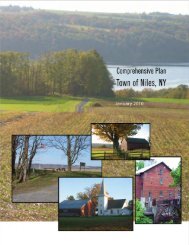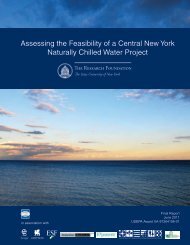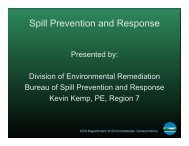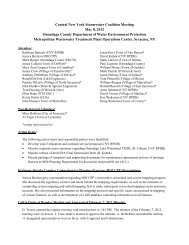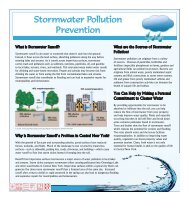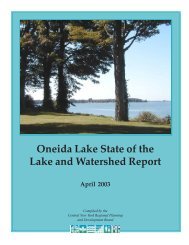A Management Strategy for Oneida Lake and its ... - CNY RPDB Home
A Management Strategy for Oneida Lake and its ... - CNY RPDB Home
A Management Strategy for Oneida Lake and its ... - CNY RPDB Home
You also want an ePaper? Increase the reach of your titles
YUMPU automatically turns print PDFs into web optimized ePapers that Google loves.
Recommendation: Develop a hydrologic model of the <strong>Oneida</strong> <strong>Lake</strong> watershed to estimate the<br />
response of precipitation <strong>and</strong> snowmelt on <strong>Oneida</strong> <strong>Lake</strong> based on the variable discharge capacity<br />
of the <strong>Oneida</strong> River. 3<br />
Potential Responsible Organizations: US ACOE, NWS, NYSCC, NYS DEC, USGS,<br />
OLWAC, <strong>CNY</strong> <strong>RPDB</strong><br />
• PROBLEM: There is a lack of stream <strong>and</strong> stage gages in the Oswego River Basin. The<br />
absence of funding has led to the discontinuation of several gages throughout the watershed<br />
<strong>and</strong> the lack of historical data poses a limitation to using models <strong>for</strong> predicting future<br />
flooding patterns.<br />
Recommendation: Encourage local, state, <strong>and</strong>/or federal governmental un<strong>its</strong> in cooperation with<br />
the USGS to fund the repair of existing stream <strong>and</strong> stage gages on Fish Creek, Limestone Creek,<br />
Chittenango Creek, <strong>and</strong> at Sylvan Beach, <strong>and</strong> to consider the potential <strong>for</strong> adding additional<br />
gages in other areas. These stage gages, coupled with stream gages, are needed to meet the<br />
requirements outlined in A1. 4<br />
Potential Responsible Organizations: USGS, OLWAC, <strong>CNY</strong> <strong>RPDB</strong><br />
C. Control Structures <strong>and</strong> Operations<br />
• PROBLEM: There is a lack of underst<strong>and</strong>ing among stakeholders regarding water level<br />
management control structures <strong>and</strong> the potential impact of technical reports compiled by<br />
groups such as the U.S. Army Corps of Engineers.<br />
Recommendation: Solicit the U.S. Army Corps of Engineers to restudy current <strong>Oneida</strong> <strong>Lake</strong><br />
flooding characteristics in terms of alternative water level control options <strong>and</strong> anticipated cost<br />
benefit analyses.<br />
Potential Responsible Organizations: US ACOE <strong>and</strong> local municipalities<br />
• PROBLEM: The NYS Canal Corporation regulates water levels during the navigation<br />
season, as required by law, <strong>and</strong> is responsible <strong>for</strong> the conditions of the canal navigation<br />
channel, not the depths of the entire width of the Canal or <strong>Oneida</strong> <strong>Lake</strong>. The majority of<br />
2 As per W. Kappel of the USGS (12/15/03 e-mail correspondence), the development of a real-time data network<br />
provides not only the pulse of the watershed to <strong>its</strong> residents, but can provide the critical data needed to develop a<br />
hydrologic <strong>and</strong> hydraulic model of the watershed. Hydrologic in this sense is a watershed model 'tuned' to the<br />
natural conditions (stream <strong>and</strong> l<strong>and</strong> slopes, stream cross-sections, soils, l<strong>and</strong>-use, etc.) within the watershed. This<br />
model needs to be coupled to a hydraulic model (i.e., the plumbing of the system) as water levels <strong>and</strong> flows are<br />
controlled by man-made structures within <strong>and</strong> downstream of the watershed.<br />
3 According to W. Kappel of the USGS (12/15/03 e-mail correspondence), funding has been cut both by USGS<br />
funding cooperators <strong>and</strong> by the Federal government. USGS does not choose where gages are situated on streams,<br />
rivers, <strong>and</strong> lakes. A funding agency (usually a local, state, or federal governmental unit) determines where USGS<br />
establishes <strong>its</strong> stations <strong>and</strong> pays USGS <strong>for</strong> this service. USGS assists in these costs through a cooperative funding<br />
program, but cuts in funding at all governmental levels has caused a diminishment in the number of gaging stations<br />
across the United States.<br />
Chapter 3: Priority Areas page 47



